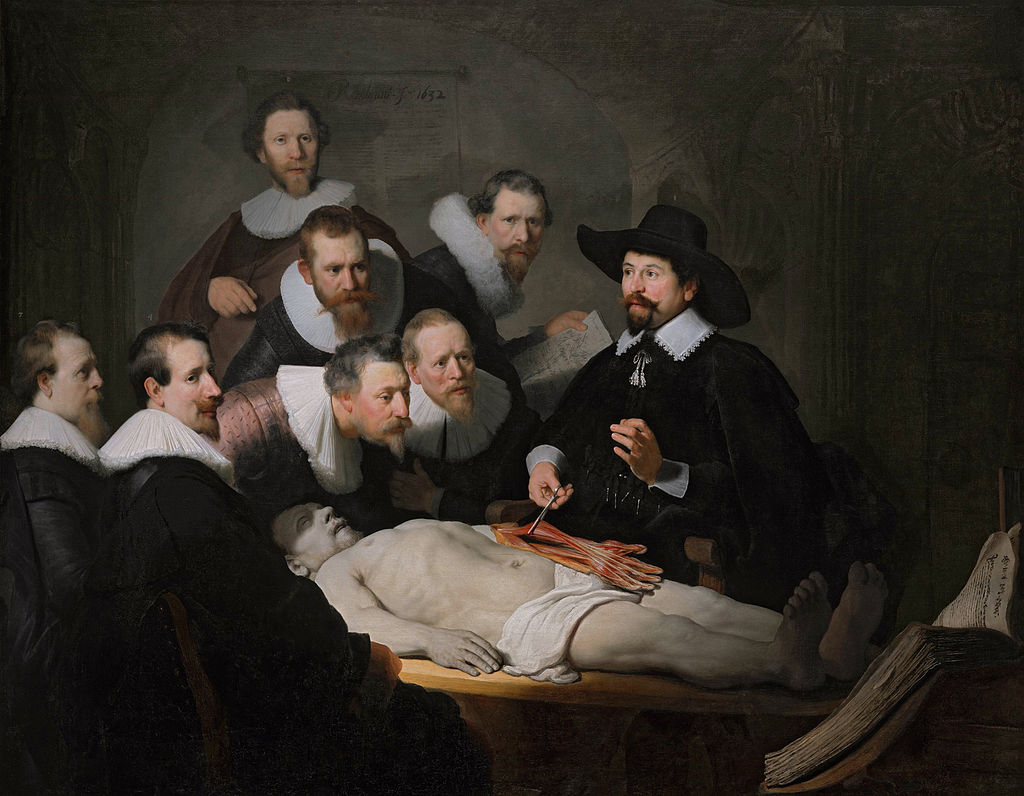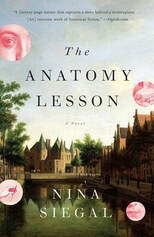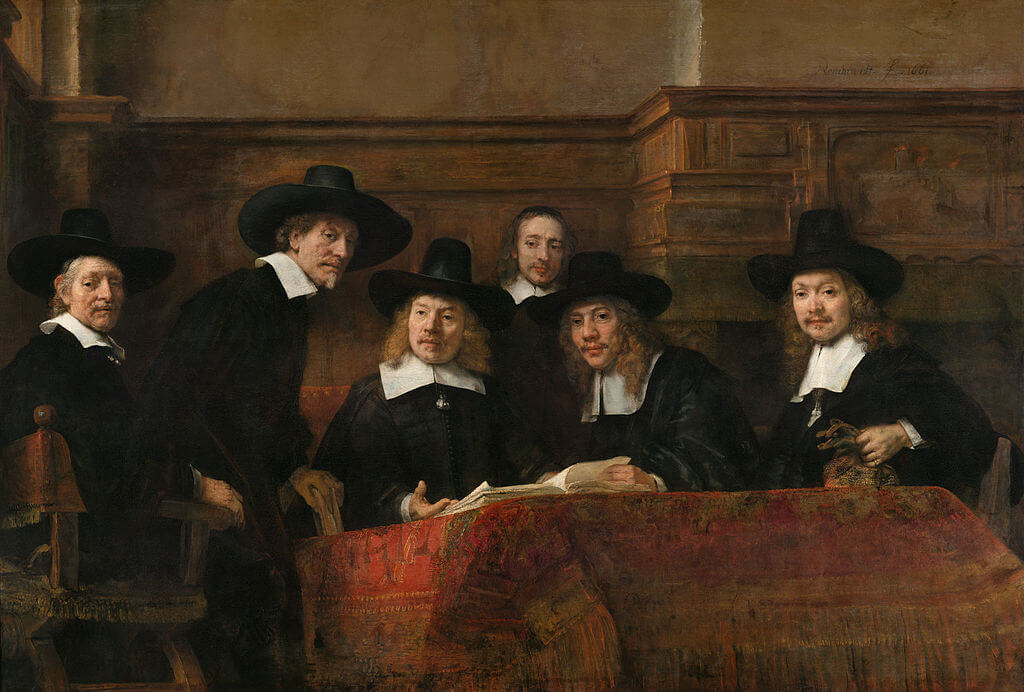|
Where? Room 9 of the Mauritshuis
When? 1632 Commissioned by? Dr. Nicolaes Tulp and the guild of surgeons in Amsterdam What do you see? Dr. Nicolaes Tulp, the central figure with the hat, is giving an anatomy lesson to the guild of surgeons. The body that he analyzes is from the criminal Aris Kindt. His body is partly shaded to indicate that he is dead (see also the black lips), which is a technique called umbra mortis (which means shadow of death). Dr. Tulp (which means “tulip” in Dutch), has an instrument (a forceps) in his right hand and shows how the muscles in the arm are attached. With his left hand, he illustrates to the audience the movement that the left arm and hand are capable of. According to the knowledge of today, Rembrandt’s depiction of the arm was surprisingly accurate, though there are some minor mistakes. The surgeons are all looking at a distinct place, although several of them seem to look at the open book on the right. The book is probably De Humani Corporis Fabrica (Fabric of the Human Body) by Andreas Vesalius and contains medical information that supplements what the surgeons hear and see in this anatomy lesson. Have a look at the white starch collars of the surgeons, which have been painted in great detail. It was very difficult to keep these collars this white and to iron them to appear in this perfect form. In this painting, they show the distinctiveness of the surgeons. Inscriptions: The man in the center back is holding a piece of paper, which contains the names of the seven spectators present on this painting. Just to the left of the top middle of the painting, you can see the text “Rembrandt f. 1632”. This text means that Rembrandt made this painting in 1632 (“f.” stand for “fecit”, which is Latin for “he made”). Backstory: This painting is part of a series of group portraits for the boardroom of the Amsterdam Guild of Surgeons. On January 31, 1632, Dr. Tulp (38 years old) gave a public anatomy lesson, which was open to surgeons, students, and the general public (who had to pay an entrance fee) and was held in a theater. Such an anatomy lesson was given once a year during the winter to reduce the deterioration of the body and its smell because it was not yet possible to refrigerate the body. By law, they could only use a body of an executed criminal for this event. Surgeons were required to attend this anatomy lesson to increase their understanding of the human body.
Who is Dr. Nicolaes Tulp? Dr. Tulp (1593-1674) was born in Amsterdam and studied medicine in Leiden starting in 1611. He was born as Claes Pieterszoon but changed his name as an adult to Nicolaus Petreius, which was a more credible name for a physician and surgeon. After he established a successful practice in Amsterdam, he changed his name to Nicolaes Tulp (after the beautiful tulips that he saw near his house).
Dr. Tulp became a surgeon specialized in anatomy, and in 1628 he became the lecturer of Amsterdam Guild of Surgeons, which made him responsible for the yearly public anatomy lesson. He was a very successful surgeon and published a popular book on anatomy. In 1653 he became the mayor of Amsterdam, where he signed the official document with the stamp of a tulip. He was reelected as mayor three times. Who is Aris Kindt? The body of the criminal that is dissected in this painting belongs to the 28-year old Adriaen Adriaenszoon, usually called Aris Kindt (which means Aris the child) and sometimes referred to as Aris ‘t Kint. Earlier that day – some sources mention one hour before – he was publicly hanged and died. Just like Rembrandt, Aris was born in Leiden. He was a thief and had already been caught many times before. Most recently, he was accused of violent robbery; he had mugged a gentleman to steal his cloak. He was convicted to death and was involuntarily paying back his debt to society by serving as the subject for an anatomy lesson. Who is Rembrandt? Rembrandt Harmenszoon van Rijn (1606-1669) is one of the greatest painters of this world. He was born in Leiden, The Netherlands. In 1631, he relocated to Amsterdam, which was one of the most important cities in the world at that time. Rembrandt was a master of using the contrast between light and dark in his work. Rembrandt was a very productive artist, and much of his work involved religious scenes, self-portraits, and portraits of others. He has created almost 100 self-portraits in his life. Together with Caravaggio, Rembrandt is by many considered to be the greatest painter of the Baroque period. This painting was one of the first assignments that Rembrandt got when he moved from Leiden to Amsterdam and immediately increased his reputation. Fun fact: This painting became quite popular in the U.S. in the middle of the 20th century as it was featured on the packaging of the Dutch Masters cigar brand. Dutch Masters is one of the most popular cigar brands in the United States. The use of this painting for branding is one of the early examples of how art can successfully be used to build a brand. The managers of Dutch Masters were smart enough to remove the dead body and the forceps from the painting before displaying it on their packaging (the complete painting, however, would not be such a strange choice in today’s tobacco packaging with all the warnings on the packages). Featuring a piece of art from Rembrandt on the packaging gave some sophistication to this relatively inexpensive cigar brand. Nowadays, another picture of Rembrandt, Syndics of the Drapers' Guild is featured on the packaging of Dutch Masters cigars. Interested in a copy for yourself? Poster or canvas.
Written by Eelco Kappe
References:
0 Comments
Leave a Reply. |
Categories
All
|
- Home
- Blog
-
Museums
- Alte Pinakothek
- Art Institute of Chicago
- Baltimore Museum of Art
- Barber Institute of Fine Arts
- Bargello
- Barnes Foundation
- British Museum
- Church of Sant’Anastasia
- Cleveland Museum of Art
- Courtauld Institute of Art
- Detroit Institute of Arts
- Frans Hals Museum
- Galleria Borghese
- Gallerie dell'Accademia
- Getty Museum
- Guggenheim
- Hermitage Museum
- Kunsthistorisches Museum
- Kunstmuseum Basel
- Legion of Honor Museum
- Louvre
- Mauritshuis
- Metropolitan Museum of Art
- Musee d’Orsay
- Museum of Fine Arts in Boston
- Museum of Modern Art
- National Gallery in London
- National Gallery of Art
- National Museum in Poznań
- Norton Simon Museum
- Ny Carlsberg Glyptotek
- Palace of Versailles
- Palazzo Pitti
- Palazzo Vecchio
- Petit Palais
- Philadelphia Museum of Art
- Prado
- Pushkin Museum
- Ravenna Art Museum
- Rijksmuseum
- San Diego Museum of Art
- Santa Maria delle Grazie
- St. Peter's Basilica
- Städel Museum
- Statens Museum for Kunst
- Tate Britain
- Tate Modern
- Timken Museum of Art
- Uffizi
- Vatican Museums
- Wallace Collection
-
Artists
- Altdorfer
- Anguissola
- Berlin Painter
- Bosch
- Botticelli
- Boucher
- Bronzino
- Bruegel the Elder
- Brunelleschi
- Cabanel
- Caillebotte
- Canova
- Caravaggio
- Carpeaux
- Cezanne
- Cimabue
- David
- Degas
- Delacroix
- De Maria
- Donatello
- El Greco
- Fontana
- Fra Angelico
- Fragonard
- Gauguin
- Gentileschi
- Gericault
- Gonzalez-Torres
- Goya
- Hals
- Hogarth
- Hokusai
- Ingres
- Leonardo da Vinci
- Lippi, Filippo
- Longhi, Barbara
- Lorrain
- Makovsky
- Manet
- Massys
- Matisse
- Merian
- Michelangelo
- Mochi
- Modigliani
- Monet
- Panini
- Parmigianino
- Perugino
- Picasso
- Pisanello
- Raphael
- Rembrandt
- Renoir
- Reynolds
- Rivera
- Rodin
- Rubens
- Scultori
- Seurat
- Steen
- Tintoretto
- Titian
- Toulouse-Lautrec
- Turner
- Uccello
- Van der Weyden
- Van Dyck
- Van Eyck
- Van Gogh
- Van Hemessen
- Vasari
- Velazquez
- Vermeer
- Veronese
- Vigée Le Brun
-
Locations
- Books
- About Us



